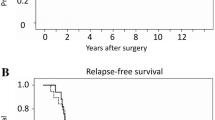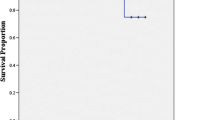Abstract
Purpose
To evaluate morbidity and oncological outcome in a multicentre series of women with gynaecological malignancies infiltrating pelvic side wall (PSW) that received laterally extended pelvic resection (LEPR).
Methods
Patients operated between 2007 and 2017 at three institutions were included. LEPR was defined as an en bloc lateral resection of a pelvic tumour involving sidewall muscle, and/or bone, and/or major nerve, and/or major vascular structure. Postsurgical complications and survivals were evaluated.
Results
Sixty-three women with gynaecological tumours involving PSW were treated with LEPR. Five women underwent primary LEPR, whereas 58 (92%) patients needed LEPR because of recurrence. Twenty-four women (38%) received previous radiation therapy before the surgery. R0 resection was achieved in 54 patients (85.7%), whereas the pathologic margins were microscopically and macroscopically positive in 8 (12.7%) patients and 1 (1.6%) patient, respectively. There was one perioperative death, whereas major postoperative complications occurred in 17 patients (27.7%). Thirty (47.5%) women experienced recurrences: 24/54 (44.4%) were in the R0 group, and 6/9 (66.6%) were in the R1 group, with a median PFS of 15 months and 7 months, respectively (p = 0.024). In total, 11 of 54 (20.3%) patients died of disease in the R0 group and 5 of 9 (55.5%) in the R1 group; a median OS was not reached and was 32 months for R0 and R1 groups, respectively (p = 0.033).
Conclusions
Involvement of the PSW should not prevent obtaining R0 resection. Although the LEPR is associated with considerable morbidity (≈ 30%), a long-term survival seems to be achieved in those women with complete resection.

Similar content being viewed by others
References
Ang C, Bryant A, Barton DP, Pomel C, Naik R. Exenterative surgery for recurrent gynaecological malignancies. Cochrane Database Syst Rev. 2014;(2):CD010449.
Hoeckel M. Long-term experience with (laterally) extended endopelvic resection (LEER) in relapsed pelvic malignancies. Curr Oncol Rep. 2015;17(3):435.
Chiantera V, Rossi M, De Iaco P, et al. Morbidity after pelvic exenteration for gynecological malignancies: a retrospective multicentric study of 230 patients. Int J Gynecol Cancer. 2014;24(1):156–64.
Shaikh I, Aston W, Hellawell G, et al. Extended lateral pelvic sidewall excision (ELSiE): an approach to optimize complete resection rates in locally advanced or recurrent anorectal cancer involving the pelvic sidewall. Tech Coloproctol. 2014;18(12):1161–8.
Vizzielli G, Fanfani F, Costantini B, Gallotta V, Scambia G, Fagotti A. External hemipelvectomy as treatment for solitary coxofemoral metastasis from endometrial carcinoma: case report and review of the literature. J Obstet Gynaecol Res. 2012;38(5):892–8.
Sardain H, Lavoue V, Redpath M, Bertheuil N, Foucher F, Levêque J. Curative pelvic exenteration for recurrent cervical carcinoma in the era of concurrent chemotherapy and radiation therapy. A systematic review. Eur J Surg Oncol. 2015;41(8):975–85.
Lakhman Y, Nougaret S, Miccò M, et al. Role of MR Imaging and FDG PET/CT in selection and follow-up of patients treated with pelvic exenteration for gynecologic malignancies. Radiographics. 2015;35(4):1295–313.
Caceres A, Mourton SM, Bochner BH, et al. Extended pelvic resections for recurrent uterine and cervical cancer: out-of-the-box surgery. Int J Gynecol Cancer. 2008;18:1139–44.
Dowdy SC, Mariani A, Cliby WA, Haddock MG, Petersen IA, Sim FH, Podratz KC. Radical pelvic resection and intraoperative radiation therapy for recurrent endometrial cancer: technique and analysis of outcomes. Gynecol Oncol. 2006;101:280–6.
Andikyan V, Khoury-Collado F, Sonoda Y, et al. Extended pelvic resections for recurrent or persistent uterine and cervical malignancies: an update on out of the box surgery. Gynecol Oncol. 2012;125(2):404–8.
Goldberg GL, Sukumvanich P, Einstein MH, Smith HO, Anderson PS, Fields AL. Total pelvic exenteration: the Albert Einstein College of Medicine/Montefiore Medical Center Experience (1987 to 2003). Gynecol Oncol. 2006;101:261–8.
Tewari KS, Sill MW, Penson RT, et al. Bevacizumab for advanced cervical cancer: final overall survival and adverse event analysis of a randomised, controlled, open-label, phase 3 trial (Gynecologic Oncology Group 240). Lancet. 2017;390:1654–63.
Solomon MJ, Brown KG, Koh CE, Lee P, Austin KK, Masya L. Lateral pelvic compartment excision during pelvic exenteration. Br J Surg. 2015;102(13):1710–7.
Vizzielli G, Chiantera V, Tinelli G, et al. Out-of-the-box pelvic surgery including iliopsoas resection for recurrent gynecological malignancies: does that make sense? A single-institution case-series. Eur J Surg Oncol. 2017;43(4):710–6.
Tinelli G, Cappuccio S, Parente E, et al. Resectability and vascular management of retroperitoneal gynecological malignancies: a large single-institution case-series. Anticancer Res. 2017;37(12):6899–906.
Cibula D, Zikan M, Fischerova D, et al. Pelvic floor reconstruction by modified rectus abdominis myoperitoneal (MRAM) flap after pelvic exenterations. Gynecol Oncol. 2017;144(3):558–63.
Cibula D. Pelvic Exenteration for gynecological cancers. In: Ramirez PT, Frumovitz M, Abu-Rustum N (eds) Principles of gynecologic oncology surgery. Publisher Elsevier, Philadelphia; 2018.
Costantini B, Vizzielli G, Fanfani F, et al. Urologic surgery in gynecologic oncology: a large single-institution experience. Eur J Surg Oncol. 2014;40(6):756–61.
Strong VE, Selby LV, Sovel M, et al. Development and assessment of Memorial Sloan Kettering Cancer center’s surgical secondary events grading system. Ann Surg Oncol. 2015;22(4):1061–7.
Kaplan EL, Meier P. Nonparametric estimation from incomplete observations. J Am Stat Assoc. 1958;53:457–81.
Mantel N. Evaluation of survival data and two new rank order statistics arising in its consideration. Cancer Chemother Rep. 1996;50:163–70.
Author information
Authors and Affiliations
Corresponding author
Ethics declarations
Disclosure
The authors have no conflicts of interest to declare.
Electronic supplementary material
Below is the link to the electronic supplementary material.
Rights and permissions
About this article
Cite this article
Vizzielli, G., Naik, R., Dostalek, L. et al. Laterally Extended Pelvic Resection for Gynaecological Malignancies: A Multicentric Experience with Out-of-the-Box Surgery. Ann Surg Oncol 26, 523–530 (2019). https://doi.org/10.1245/s10434-018-07088-8
Received:
Published:
Issue Date:
DOI: https://doi.org/10.1245/s10434-018-07088-8




